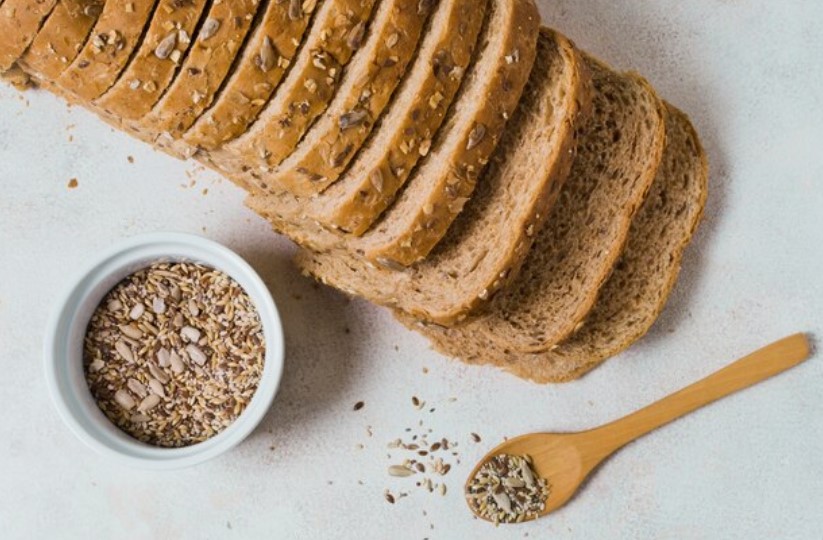Introduction Gluten Free Bread Crumb
Gluten-free breadcrumbs are an excellent way to utilize stale Gluten Free Bread Crumbs. They are described as crunchy, savory, and simple to make. The process involves using a food processor to create fine crumbs from cubed, stale bread, which are then seasoned and baked until lightly toasted. These breadcrumbs can be stored in an airtight container and used in various recipes, such as coatings for chicken cutlets, in meatballs, or as a crouton substitute in salads.
Key Points about Gluten-Free Breadcrumbs
- The Best Bread for Breadcrumbs: Not all gluten-free breads are suitable for making breadcrumbs. The ideal choice is a lean bread or slightly enriched bread, avoiding those made with sweet dough.
- Making Process: The breadcrumbs are made by pulsing cubed stale bread in a food processor, seasoning them, and then baking them in the oven until they achieve a crunchy texture.
- Storage and Usage: Once cooled, the breadcrumbs can be stored at room temperature or frozen for later use. They are versatile and can be used in various dishes, from coatings for fried foods to salad toppings.
For more detailed information and recipes, you can visit the original article on Let Them Eat Gluten Free Cake.
Ingredients Gluten Free Bread Crumb
- Gluten-Free Bread: You’ll need 4-5 cups of stale, cubed gluten-free bread. Choose any type that you prefer.
- Optional Seasoning:
- Italian seasoning: ideally 1-2 tablespoons, but adjust to your liking.
- Kosher salt: about 1 teaspoon.
- Cracked black pepper: roughly ½ teaspoon.
Presentation: Homemade Gluten Free Bread Crumb
- Preheat the Oven: Firstly, heat your oven to 350°F (175°C).
- Prepare the bread. Then, spread the bread cubes on a baking sheet. If they’re not stale yet, dry them in the oven for a few minutes.
- Process the Bread: Next, put the dried bread cubes in a food processor. Keep pulsing them until they turn into a mix of fine and larger crumbs.
- Season the Crumbs: Now, move the crumbs to a bowl. Add the Italian seasoning, salt, and pepper. Stir everything well to combine.
- Bake the Breadcrumbs: Subsequently, lay out the seasoned breadcrumbs in a single layer on a baking sheet. Bake them for 20–25 minutes. Make sure to stir occasionally until they become lightly toasted and dry.
- Cool and Store: Lastly, let the breadcrumbs cool at room temperature. Then, store them in an airtight container. They will stay fresh for a few weeks at room temperature, or you can opt to freeze them for extended storage.
This recipe is a fantastic way to make your own gluten-free breadcrumbs. It allows for customization with your preferred bread and seasonings. These breadcrumbs are ideal for various recipes, adding a delightful crunch to your culinary creations.
Ingredients
- Gluten-Free Bread: 4-5 cups, preferably cubed and stale
- Italian Seasoning: Optionally, 1-2 tablespoons (adjust to taste)
- Kosher Salt: Roughly 1 teaspoon
- Cracked Black Pepper: About ½ teaspoon
Step Gluten Free Bread Crumb
- Oven Preheating: Firstly, preheat your oven to 350°F (175°C).
- Bread Preparation: Secondly, if your gluten-free bread isn’t already stale, cube it and spread it out on a baking sheet. Then, briefly dry it in the oven.
- Bread Processing: Next, take the dried bread cubes and put them in a food processor. Pulse the bread until it breaks down into a mix of fine and slightly larger crumbs.
- Adding Seasonings: Afterward, move the breadcrumbs to a bowl. Mix in the Italian seasoning, salt, and pepper until everything is evenly combined.
- Baking: Now, lay out the seasoned breadcrumbs on a baking sheet in a single layer. Bake them in the preheated oven for 20–25 minutes. Remember to stir occasionally for even toasting.
- Cooling and Storing: Finally, after baking, let the breadcrumbs cool to room temperature. Store them in an airtight container. They will remain fresh for a few weeks at room temperature, or alternatively, you can freeze them for longer storage.
This approach ensures you have a straightforward and effective method for making gluten-free breadcrumbs at home. These breadcrumbs can be a versatile addition to various gluten-free recipes, enhancing texture and flavor.
Storage of Gluten-Free Breadcrumbs
Short-Term Storage
- Cool Completely: Ensure that the breadcrumbs have cooled down to room temperature after baking.
- Airtight Container: Transfer the cooled breadcrumbs to an airtight container. This helps to keep out moisture and other contaminants.
- Room Temperature: Store the container in a cool, dry place. A pantry or kitchen cabinet is ideal.
- Duration: Properly stored, the breadcrumbs should stay fresh for up to a few weeks.
Long-Term Storage
- Freezing: For longer storage, freezing is an excellent option.
- Freezer-Safe Container or Bag: Place the breadcrumbs in a freezer-safe container or a resealable freezer bag. If using a bag, try to remove as much air as possible before sealing.
- Label and Date: It’s helpful to label the container or bag with the date of storage.
- Freezer Storage: Store the container or bag in the freezer.
- Duration: In the freezer, the breadcrumbs can last for several months.
Usage Tips
- Thawing: When you’re ready to use the breadcrumbs, thaw them at room temperature. If you are in a hurry, you can also spread them on a baking sheet and warm them slightly in the oven.
- Check for Freshness: Before using, give the breadcrumbs a quick check for any signs of spoilage, especially if they’ve been stored for a longer period.
By following these storage tips, you can ensure that your homemade gluten-free breadcrumbs remain fresh and are ready to use whenever you need them for your cooking or baking projects.
History of Breadcrumbs and the Emergence of Gluten-Free Variants
Early Use of Breadcrumbs
- Ancient and Medieval Cuisine: Breadcrumbs have been used in cooking for centuries. In ancient Rome, for instance, they were often used as a thickener for stews and sauces. During medieval times, they played a significant role in European cuisine, being used in dishes like stuffings and coatings for fried foods.
Evolution in Cooking
- 19th and 20th Centuries: With the industrialization of food production, breadcrumbs became more widely available and were used in a variety of dishes, from coatings for fried foods to binders in meatloaf and casseroles.
Rise of Dietary Awareness
- Late 20th Century: As awareness of dietary needs and food allergies increased, particularly concerning gluten intolerance and celiac disease, the demand for gluten-free options grew.
Development of Gluten-Free Breadcrumbs
- Gluten-Free Movement: In response to this growing awareness and need, food manufacturers and home cooks began developing gluten-free alternatives to traditional wheat-based breadcrumbs. This involved using gluten-free bread made from alternative flours like rice, almond, or potato flour.
Modern Trends
- 21st Century: Today, gluten-free breadcrumbs are readily available in many stores and are used in a variety of culinary applications. They cater not only to those with gluten sensitivities but also to people looking for diverse dietary options.
Culinary Innovation
- Continued Innovation: Chefs and home cooks continue to experiment with different types of gluten-free bread and seasonings, expanding the culinary possibilities of gluten-free breadcrumbs.
The history of breadcrumbs, culminating in the development of gluten-free versions, reflects a broader narrative of culinary adaptation and innovation. It shows how traditional cooking methods and ingredients can be adapted to meet modern dietary needs and preferences.
Conclusion Gluten Free Bread Crumb
Gluten-free breadcrumbs represent a significant culinary innovation, especially for those with gluten sensitivities or celiac disease. They exemplify how traditional cooking ingredients can be adapted to meet modern dietary needs and preferences. Originating from ancient culinary practices where breadcrumbs were used as thickeners and coatings, the evolution of breadcrumbs has mirrored changes in food production and dietary awareness.
With the rise of gluten-free diets, the development of gluten-free breadcrumbs using alternative flours like rice, almond, or potato flour has been a crucial step. These breadcrumbs not only provide a safe alternative for those who must avoid gluten but also offer new textures and flavors for culinary exploration. They demonstrate the versatility and adaptability of cooking practices, accommodating a range of dietary requirements without compromising on taste or quality.
As we continue to see growth in dietary awareness and preferences, gluten-free breadcrumbs stand as a testament to the ongoing innovation in the culinary world. They ensure that everyone, regardless of dietary restrictions, can enjoy a wide range of delicious and satisfying dishes.
FAQs on Gluten Free Bread Crumb
1. Can I use gluten-free breadcrumbs in the same way as regular breadcrumbs?
Answer: Absolutely! Gluten-free breadcrumbs can be used in the same way as regular breadcrumbs. They are perfect for coating, thickening, or adding a crunchy topping to various dishes. Whether you’re making breaded chicken, meatballs, or a crispy topping for casseroles, gluten-free breadcrumbs are a versatile substitute.
2. How do I make gluten-free breadcrumbs at home?
Answer: Making gluten-free breadcrumbs at home is simple. Start with stale, gluten-free bread. Cube the bread and dry it out in the oven if it’s not already stale. Then, pulse the dried bread in a food processor until it reaches your desired consistency. For added flavor, you can mix in seasonings like herbs, salt, and pepper. Bake the seasoned crumbs in the oven until they’re dry and crispy, and then store them in an airtight container.

